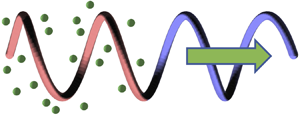Article contents
Phoretic self-propulsion of helical active particles
Published online by Cambridge University Press: 01 October 2021
Abstract

Chemically active colloids self-propel by catalysing the decomposition of molecular ‘fuel’ available in the surrounding solution. If the various molecular species involved in the reaction have distinct interactions with the colloid surface, and if the colloid has some intrinsic asymmetry in its surface chemistry or geometry, there will be phoretic flows in an interfacial layer surrounding the particle, leading to directed motion. Most studies of chemically active colloids have focused on spherical, axisymmetric ‘Janus’ particles, which (in the bulk, and in absence of fluctuations) simply move in a straight line. For particles with a complex (non-spherical and non-axisymmetric) geometry, the dynamics can be much richer. Here, we consider chemically active helices. Via numerical calculations and slender body theory, we study how the translational and rotational velocities of the particle depend on geometry and the distribution of catalytic activity over the particle surface. We confirm the recent finding of Katsamba et al. (J. Fluid Mech., vol. 898, 2020, p. A24) that both tangential and circumferential concentration gradients contribute to the particle velocity. The relative importance of these contributions has a strong impact on the motion of the particle. We show that, by a judicious choice of the particle design parameters, one can suppress components of angular velocity that are perpendicular to the screw axis, or even select for purely ‘sideways’ translation of the helix.
- Type
- JFM Papers
- Information
- Copyright
- © The Author(s), 2021. Published by Cambridge University Press
References
REFERENCES
- 13
- Cited by



